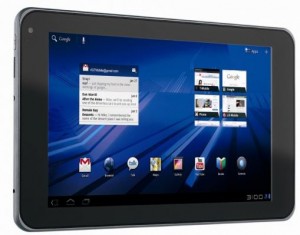
By
Rob ScottApril 29, 2011
The new G-Slate tablet from LG (sold by T-Mobile) was launched last week as the first tablet in the U.S. using Google’s Honeycomb software (Android 3.0 for tablets) to offer 4G speed and 3D video. With an 8.9-inch screen, the G-Slate offers less viewing area than Apple’s iPad 2 and the Motorola Xoom, but more than the Samsung Galaxy Tab and RIM’s BlackBerry PlayBook.
 The greatest challenges for the new device may be how to compete with the highly successful iPad — and how to differentiate itself from the other Android-based devices currently on the market. In his WSJ “All Things Digital” column, Walt Mossberg suggests that the G-Slate aims to be different in three major ways: by offering 4G cellular data speeds, enabling 3D video creation and viewing, and featuring an “in-between” screen size as compared to current offerings.
The greatest challenges for the new device may be how to compete with the highly successful iPad — and how to differentiate itself from the other Android-based devices currently on the market. In his WSJ “All Things Digital” column, Walt Mossberg suggests that the G-Slate aims to be different in three major ways: by offering 4G cellular data speeds, enabling 3D video creation and viewing, and featuring an “in-between” screen size as compared to current offerings.
In his review, Mossberg found the performance to be on par with the Honeycomb Xoom, but overall not as good a choice as the iPad 2 (especially in terms of price, size and weight). And regarding the 3D functionality, he writes, “The 3D feature, which requires the use of 1950s-style colored glasses, seems like a parlor trick to me.”
Mossberg reports that the biggest selling point of the G-Slate is the 4G speed, but adds that the current problem with all Honeycomb devices involves a lack of “tablet-optimized third-party apps.” It’s tough to compete with Apple in this regard, considering it already claims 65,000 tablet apps.
Mossberg’s bottom line: “The G-Slate isn’t as good a tablet as the iPad 2. I’d only recommend it for people who want the higher cellular speeds, or who prefer Android.”

By
Rob ScottApril 29, 2011
Former Apple engineers Kimon Tsinteris and Mike Matas have created a digital creation tool that might have a dramatic impact on the “frictionless” self-publishing of electronic books. Book apps created with the platform will leverage the sensors, touchscreen gestures, microphone and graphics chip of the iPad and iPhone to create a more interactive experience for electronic reading. The duo’s Push Pop Press is getting an interesting start, with some help from former vice president Al Gore.
 According to the Wired Gadget Lab: “Push Pop Press will be a publishing platform for authors, publishers and artists to turn their books into interactive iPad or iPhone apps — no programming skills required.” The app enables users to augment their stories with photos, videos and a compelling variety of interactive features, which could go beyond books to the publishing of magazines and newspapers.
According to the Wired Gadget Lab: “Push Pop Press will be a publishing platform for authors, publishers and artists to turn their books into interactive iPad or iPhone apps — no programming skills required.” The app enables users to augment their stories with photos, videos and a compelling variety of interactive features, which could go beyond books to the publishing of magazines and newspapers.
Push Pop Press could become an affordable alternative to the tools featured in Adobe’s Creative Suite, commonly used for creating today’s tablet periodicals. For example, Tsinteris and Matas claim that interactive diagrams, geotagged photos and video content can easily be embedded in a book produced with the tool.
For those who may be interested in seeing the possibilities of Push Pop Press, the app version of Al Gore’s book, Our Choice: A Plan to Solve the Climate Crisis, is available for $4.99 via the iTunes store.
You can also check out Gore’s guided tour of the app on the Wired post or the Push Pop Press site. It’s worth the two minutes to see this in action.

By
Rob ScottApril 28, 2011
At the 2011 NAB show in Las Vegas, filmmaker James Cameron and 3D production expert and cinematographer Vince Pace discussed their newly-formed company, the Cameron-Pace Group (CPG), aimed at promoting 3D production and streamlining its processes with the FUSION 3D camera and workflow packages.
 According to the company’s website: “CPG’s expansion will include proven solutions for 3D productions worldwide including industry-wide 3D advocacy, driving innovations in technology, and delivering products, services and creative tools for filmmakers and broadcasters in ways never addressed or witnessed before.”
According to the company’s website: “CPG’s expansion will include proven solutions for 3D productions worldwide including industry-wide 3D advocacy, driving innovations in technology, and delivering products, services and creative tools for filmmakers and broadcasters in ways never addressed or witnessed before.”
Headquartered in Burbank, the company already has 53 employees. “Our goal,” Cameron said at NAB, “is to banish all the perceived and actual barriers to entry that are currently holding back producers, studios and networks from embracing the 3D future.”
Broadcast Engineering reports that upcoming CPG projects include the ESPN X Games 17, the NBA Finals, and feature films such as Pirates of the Caribbean: On Stranger Tides, Transformers: Dark Side of the Moon, The Three Musketeers and Martin Scorsese’s The Invention of Hugo Cabret.
For more information, the Cameron-Pace Group company overview is available in PDF format.
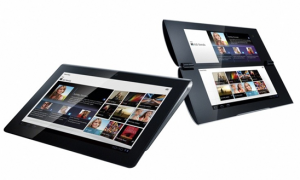
By
Rob ScottApril 26, 2011
At a Tokyo press event, Sony announced a pair of Android 3.0 tablets — the S1, featuring a 9.4-inch touchscreen display, and the smaller S2, with dual-screen 5.5-inch displays that can can fold like a book. The tablets will connect to Sony’s cloud-computing library of movies and music in addition to Sony PlayStation Android-based games and digital books from Sony’s Reader store.
 The S1 media tablet features front- and rear-facing cameras and what Engadget describes as “a curved wrap design that resembles a folded magazine.” The S1 also features a Tegra 2 SoC, touch panel UI, and integrated infrared for use as a remote control for Sony devices. The second tablet, the dual-screen S2 clamshell, features two 1024 x 480 pixel displays, Tegra 2 SoC, and camera. Engadget reports: “Sony takes advantage of the two screens with a custom book-style UI layout for its e-reader app, split keyboard and messaging displays for email, and split display and game controllers for PS One gaming.”
The S1 media tablet features front- and rear-facing cameras and what Engadget describes as “a curved wrap design that resembles a folded magazine.” The S1 also features a Tegra 2 SoC, touch panel UI, and integrated infrared for use as a remote control for Sony devices. The second tablet, the dual-screen S2 clamshell, features two 1024 x 480 pixel displays, Tegra 2 SoC, and camera. Engadget reports: “Sony takes advantage of the two screens with a custom book-style UI layout for its e-reader app, split keyboard and messaging displays for email, and split display and game controllers for PS One gaming.”
In a video report, IDG reports the S1 and S2 are PlayStation certified, WiFi and 3G/4G compatible, and will support DLNA (enabling users to buy a movie from the online Qriocity store, for example, and stream the content to a TV from the tablet via WiFi).
Sony said the devices will go on sale worldwide by September. The company has yet to announce prices, but according to Engadget: “…sources told us back in February that Sony was considering a $599 MSRP on the S1 while the S2 would likely come in at $699. Still no word on the Windows 7 slider but with the other two leaks official, it’s now only a matter of time.”
Related Huffington Post article: “Sony Shows Off S1, S2 Honeycomb Tablets With PlayStation Integration” (4/26/11)
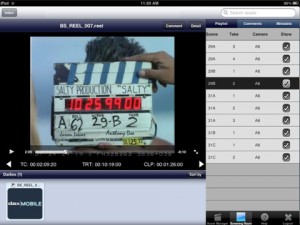
By
Rob ScottApril 25, 2011
As part of the next step toward streamlining the film and television production workflow, Sample Digital and Technicolor have introduced apps that enable executives to view “dailies” on their iPads. According to the Los Angeles Times, the apps provide production execs around-the-clock mobile access to daily footage, scripts, visual-effects shots and trailers.
 “Until a few years ago, dailies from shoots were typically stored on DVDs and then shipped to various locations, a process that became more costly as production increasingly moved out of Hollywood and projects took on multiple financing partners. More recently, dailies are delivered online and accessible on PCs and laptops, which aren’t as easy to lug around as a tablet.”
“Until a few years ago, dailies from shoots were typically stored on DVDs and then shipped to various locations, a process that became more costly as production increasingly moved out of Hollywood and projects took on multiple financing partners. More recently, dailies are delivered online and accessible on PCs and laptops, which aren’t as easy to lug around as a tablet.”
The dax|Mobile app from Sample Digital costs $249.99 on the iTunes store, while the subscription-based digital workflow system runs $1,250 to $2,000 per TV episode and up to $15,000 per movie. Encryption for the streaming video to prevent illegal copying is available for an additional fee.
Additionally, Technicolor has teamed with PureBlend Software Design Group to offer the Technicolor MovieSlate on-location production app that works for both Android and iOS systems to provide access to dailies and other content.

By
Rob ScottApril 15, 2011
The movie karaoke game, Yoostar 2 is designed to put players in scenes from their favorite movies and TV shows, enabling them to “perform” with professional actors. Users can then post the resulting video clips on the Yoostar web site, or social networking sites such as Facebook and Myspace. Yoostar 2 for the Xbox 360 Kinect and PlayStation Move was released last month.
 The connectivity between gaming and social networking could mark the first step toward an experiment that might soften the tension amongst developers in the two arenas.
The connectivity between gaming and social networking could mark the first step toward an experiment that might soften the tension amongst developers in the two arenas.
Scott Steinberg writes in a Mashable post: “You can seamlessly upload video performances online via PlayStation Network or Xbox Live right to social networks, where others can vote, bestow Internet fame and follow your antics. Using the service, it’s not only possible to share viral videos of you doing your best impression of Marlon Brando in ‘The Godfather’ via Facebook and Twitter. You can also earn rewards that unlock content in the disc-based console versions of the game.”
In an era where major game publishers tend to categorize social games into standalone experiences, Yoostar 2 may represent “one of the first efforts to bridge the gap between devices and platforms.”
Steinberg provides an interesting six-minute video report from the Yoostar offices in Santa Monica, California that includes interviews, demos and footage from the game, and of particular interest, the technology used to eliminate the need for green screen.

By
Rob ScottApril 13, 2011
Rob Woodbridge of UNTETHER.tv hosts a three-person online video panel for Episode 12 of his site’s program, The Week in Mobile. The informal 56-minute discussion provides an interesting take on how mobility is shaping content consumption — with a focus on “The iPad Effect” and its rapidly developing impact on the PC industry.
The panel cites a recent Fast Company article in which analysts anticipate 35 of the 45 million tablets expected to sell in the upcoming year will be iPads and that the only way for others such as Dell, Motorola, Samsung and RIM to compete with Apple is to dramatically undercut the price — begging the question, “Is the tablet PC industry really an industry yet at all?”
Additionally, as PC makers are being adversely impacted by the growing success of the iPad — not only with tablet sales, but in regards to laptops and desktops sales — another result may be the surprising “stealthy” success of MacBook Airs (for which the panel credits the proliferation of apps). According to Fast Company, the Air grabbed 15 percent of of the total notebook sales for the last quarter of 2010.
The discussion also addresses mobile privacy abuse in a new era of apps and Amazon’s concern regarding the consumer power enabled by NFC wireless technologies.
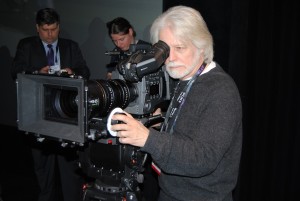
By
Rob ScottApril 12, 2011
Sony unveiled its new F65 CineAlta digital motion picture camera at an NAB press conference in Las Vegas this week. The F65 camera features a 20.4 megapixel, Super 35mm CMOS sensor, a significant jump from the F35’s 12.4 megapixel 1080p CCD. Is this another step away from film as a motion picture medium?

Pictured on the left is Curtis Clark (ASC) who directed a 4K short with the new camera, that is being shown at NAB.
According to Engadget: “…this sensor is fast — not only can it capture up to 72fps on 4K, but it can also crank up to a smooth 120fps on 2K. As for those seeking to squeeze out every bit of detail from their clips, don’t worry: the F65’s got you covered with a 16-bit RAW output (19Gbps) at 4K resolution, or it can be compressed to 5Gbps for the convenience of recording onto the new SR-R4 portable 4K recorder. Looks like Sony’s finally found a candidate that’ll put a lid on film stock, but then again, at the end of the day it’ll depend on the price tag when it comes out in Q3 this year.”
Sony also announced 2 new professional 3D cameras at NAB (and for consumers, the company announced the 3D Handycam and 3D Bloggie cameras at January’s CES).
Read the Sony Blog report on the NAB unveiling: “Sony Kicks off NAB with the announcement of a new 4K professional camera” (4/11/11)
Related Engadget post: “Sony shoots out CineAlta F65 4K camera and PMW-TD300 3D camcorder at NAB” (4/11/11)
The Photography Bay write-up includes video coverage of the NAB press conference and behind-the-scenes footage with Curtis Clark directing a 4K short with the new camera.

By
Rob ScottApril 11, 2011
GoPro is gaining in consumer popularity thanks to its collection of Hero Camera mounts that allow users to attach inexpensive cameras to everything from ski helmets to the tips of surfboards for action footage. Already popular with skiers, snowboarders, surfers, bikers and other outdoor enthusiasts and extreme athletes, the GoPro line is starting to become more common with professional cameramen as well. Nature photographers, in particular, are using GoPro products to shoot footage of hard-to-reach places, such as inside a cobra’s den or a shark’s mouth.
 The small, six-ounce, 1080p camera comes with a water-tight housing and starts at $260.
The small, six-ounce, 1080p camera comes with a water-tight housing and starts at $260.
GoPro’s parent company, Woodman Labs Inc., is receiving funding from outside investors, including Steamboat Ventures, a venture capital fund backed by Disney (Steamboat Ventures was also an investor in Pure Digital, maker of the popular Flip pocket camcorder). Steamboat plans to help GoPro expand further into the professional market.
Gizmodo offers a positive review of the 3D Hero System — a $99 3D kit (cameras not included) that GoPro bills as “the world’s smallest 1080p 3D camera.” The system combines two HD cameras in a waterproof housing that enables users to shoot synchronized photos and video (2D and 3D) that can then be edited in 3D with the free CineForm Studio software.
Most helmet and similar cameras have gone to wide angle lenses to ensure footage and minimize shake. The result was effective, but made things look smaller when viewed. Gizmodo notes that “adding 3D gives depth to the trees and objects rushing past you,” providing for a more immersive viewing experience.
You can check out the GoPro video demo to see how the 3D Hero System works.
Related Wall Street Journal story: “Camcorder Popular With Surfers Looks to Ride Professional Market” (4/6/11)
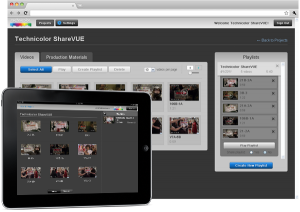
By
Rob ScottApril 10, 2011
Technicolor announced its next-generation secure, cloud-based dailies solution for film and television studio clients. According to the press release, ShareVUE enables remote viewing, collaboration and sharing of dailies content on HTML5-supported web browsers, iOS and Android devices. Technicolor explains it is working with the Squeeze Solution Pack encoding technology from Sorenson Media to implement cloud-based scalability.
 ShareVUE features include:
ShareVUE features include:
— A central hub to remotely view production materials while sharing time-stamped comments and playlists.
— A single encode that is transcoded and optimized “behind-the-scenes” to maximize visual quality for each supported device.
— Streaming-only model ensures media security, and includes content protection protocols combined with link encryption protocols, content scrambling and dynamic watermarking techniques.
Related Variety article: “Technicolor, Canon pact for cinematographers” (4/5/11)
By
Rob ScottApril 10, 2011
Michael White took over the reigns of DirecTV the beginning of this year as the new president and CEO. During a recent three-day retreat with senior executives, White outlined the company’s strengths and weaknesses, and shared his vision for future growth, especially in regards to possible expansion in Latin America and reaching out to customers who use mobile devices. Investor’s Business Daily reports that DirecTV “is the world’s largest pay TV services provider with more than 28 million subscribers in the U.S. and Latin America.”
White emphasized that DirecTV is in excellent shape, but that an effective strategic plan would help steer the company into the future. His immediate focus is on recent deals with AT&T and Verizon that allow DirecTV to sell broadband services over fiber networks, the next phase of DirecTV’s recently launched free iPad application, and expanding the number of customers in Latin America (currently at 9 million).
“I was convinced that Latin America was still the best growth opportunity, and we should really expand more aggressively in Latin America,” White said. “In the U.S., we had a terrific core business, but we needed to address the ‘anytime, anywhere’ TV evolution and we needed some other revenue growth opportunities to help drive the top line while we were wrestling with higher programming costs.”
DirecTV’s first iPad app has some interesting features, yet is somewhat limited in its functionality for those truly on-the-go. It can serve as a remote control to change channels, browse channels without interrupting what’s on TV at the time, record to a DVR, and create a home screen with access to favorite channels. Users can use the app outside the home to schedule programs, but cannot currently use it to view programming. This may be the biggest obstacle for mobile device enthusiasts. White explains that phase two will enable users to import DVR content that has already been recorded to the iPad for remote viewing.
White says that DirecTV’s strategy to increase market share in Latin America involves a segmented approach by focusing on the quality of HD and DVR offerings — in addition to offering lower-priced packages, specifically targeting the middle-class who have so far been reluctant to take the plunge with paid services.

By
Rob ScottApril 9, 2011
In his first public appearance since joining Hewlett-Packard in November, CEO Leo Apotheker delivered a speech in San Francisco that outlined the company’s new online strategy that he explained will target both consumers and businesses. Apotheker emphasized cloud computing and an online app store as part of his vision to bring HP to the forefront as “the platform for the cloud and connectivity.” He suggested that the app store would include programs from HP as well as from other companies.
 Apotheker dismissed speculation that HP would be acquiring software maker SAP AG or any other provider of transactional business programs. The Wall Street Journal reports that his goal is to address the “increasing amount of unstructured data — information that isn’t easily categorized”; HP will “focus on products and services that will help businesses better make sense of them.”
Apotheker dismissed speculation that HP would be acquiring software maker SAP AG or any other provider of transactional business programs. The Wall Street Journal reports that his goal is to address the “increasing amount of unstructured data — information that isn’t easily categorized”; HP will “focus on products and services that will help businesses better make sense of them.”
Apotheker explained that the company’s webOS operating system (newly acquired along with Palm last year) is designed for smartphones and tablets, but will also ship on HP PCs, providing the company with a greater scale. HP plans to produce laptops and desktops with webOS working alongside Windows, enabling computers to interact with HP’s smartphones and tablets.

By
Rob ScottApril 9, 2011
We recently reported on a number of new features and trends regarding media consumption via tablet PCs, especially since an onslaught of new iPad apps have been making headlines. One such potential trend may involve synchronized bonus content and interactive features related to live TV shows.
 In February, Fox announced the availability of its free app for the series Bones, that enables access to a series of content add-ons while viewing the program live or via Fox.com, Hulu or DVR. Features include social media integration (users can comment with other fans and try to solve cases) and the ability to purchase songs played during the show from iTunes. The Fox launch follows the release of ABC’s iPad sync app for the hit drama series Grey’s Anatomy.
In February, Fox announced the availability of its free app for the series Bones, that enables access to a series of content add-ons while viewing the program live or via Fox.com, Hulu or DVR. Features include social media integration (users can comment with other fans and try to solve cases) and the ability to purchase songs played during the show from iTunes. The Fox launch follows the release of ABC’s iPad sync app for the hit drama series Grey’s Anatomy.
As content providers, perhaps we should be looking beyond complementary content for tablets, and consider what additional video approaches might leverage this growing platform. According to paidContent: “It’s interesting that so far the TV industry is treating tablets more as a sidecar for original programming on TV than a source of original content in its own right, as News Corp.‘s new The Daily is trying to do. Or perhaps sometime soon we’ll see a video-centric company try to evolve its product on the iPad the way News Corp. wants to do same for the news business.”
The paidContent article includes an interesting video promo for the free Grey’s Anatomy iPad app that features interactive components such as polls, quizzes, bonus content, and more.

By
Rob ScottApril 7, 2011
The New York Times offers an interesting perspective regarding how digital technologies have impacted the production, distribution, marketing and exhibition of contemporary movies. The article addresses a compelling focus in terms of how the communal aspect of viewing film is facing a dramatic cultural shift and how filmgoing has become less of a group experience. Have we reached a new milestone that may require us to redefine the term “cinema” — and, if so, what does this mean for the business of filmmaking?
 The article cites the fact that theater attendance has declined in the U.S. from 90 million a week in 1948 to approximately 23 million today. Of course, the 1948 audience did not have Blu-ray, on-demand, cable movie channels, streaming services and an array of new technologies that enable today’s “24-hour movie.”
The article cites the fact that theater attendance has declined in the U.S. from 90 million a week in 1948 to approximately 23 million today. Of course, the 1948 audience did not have Blu-ray, on-demand, cable movie channels, streaming services and an array of new technologies that enable today’s “24-hour movie.”
Technological innovation has led to cultural evolution regarding the traditional cinema experience. For many consumers, experiencing a movie is no longer about the anticipation of a release, the social environment created by sitting in a darkened theater with a date or a friend (and a group of strangers), or the “communal laughter, tears, gasps and heckling that become part of our memories.” For many (perhaps most), the experience is now more about clicking a button — and what has become a more personalized, immediate dynamic based on consumption-on-demand that technologies enable.
If the 24-hour movie continues to impact the demands and expectations of the movie-viewing public, will this require us to rethink how we produce, exhibit and market our content?

By
Rob ScottApril 4, 2011
In the wake of disappointing 3D TV sales for 2010 (due in large part to a lack of 3D content), this year may see new traction as television vendors switch their strategy to marketing 3D as one feature of new high-def sets, rather than the single selling point. More 3D content is on the horizon via cable and satellite TV channels, Blu-ray Discs and video games. Eventual adoption may also be impacted as consumers shoot their own video with 3D-enabled camcorders.
 Disney’s ESPN 3D sports channel began broadcasting in mid-February — while Sony, Discovery and Imax launched their 3net channel the same month. Comcast and DirecTV already have 3D channels, and more than 100 3D channels worldwide are expected by 2015.
Disney’s ESPN 3D sports channel began broadcasting in mid-February — while Sony, Discovery and Imax launched their 3net channel the same month. Comcast and DirecTV already have 3D channels, and more than 100 3D channels worldwide are expected by 2015.
“Clearly, lack of content has been holding the market back,” explained Chris Chinnock, president of research firm Insight Media. “But one or two years into the HDTV transition there wasn’t much programming either … It took about seven years to reach 11 percent (household) penetration with HDTV.”
DisplaySearch predicts 6.6 million 3D TVs will ship in North America in 2011 (16 percent of the more than 40 million sets expected to be sold). The research and consulting firm is targeting 15.2 million 3D TVs to ship in 2012 (up 130 percent).
 The greatest challenges for the new device may be how to compete with the highly successful iPad — and how to differentiate itself from the other Android-based devices currently on the market. In his WSJ “All Things Digital” column, Walt Mossberg suggests that the G-Slate aims to be different in three major ways: by offering 4G cellular data speeds, enabling 3D video creation and viewing, and featuring an “in-between” screen size as compared to current offerings.
The greatest challenges for the new device may be how to compete with the highly successful iPad — and how to differentiate itself from the other Android-based devices currently on the market. In his WSJ “All Things Digital” column, Walt Mossberg suggests that the G-Slate aims to be different in three major ways: by offering 4G cellular data speeds, enabling 3D video creation and viewing, and featuring an “in-between” screen size as compared to current offerings.
























